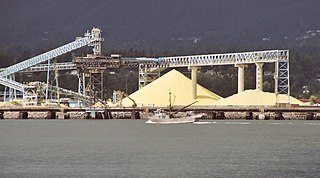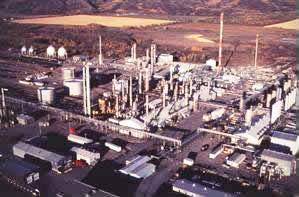
Sulfur or sulphur is a chemical element with symbol S and atomic number 16. It is abundant, multivalent, and nonmetallic. Under normal conditions, sulfur atoms form cyclic octatomic molecules with a chemical formula S8. Elemental sulfur is a bright yellow, crystalline solid at room temperature.

Sodium sulfite (sodium sulphite) is a soluble sodium salt of sulfurous acid (sulfite) with the chemical formula Na2SO3. It is also used as a preservative to prevent dried fruit from discoloring, and for preserving meats, and is used in the same way as sodium thiosulfate to convert elemental halogens to their respective hydrohalic acids, in photography and for reducing chlorine levels in pools. In boiler systems, sulfite and bisulfite are the most commonly employed oxygen scavengers used to prevent pitting corrosion. Sodium sulfite is also a byproduct of sulfur dioxide scrubbing, a part of the flue-gas desulfurization process.

Flue-gas desulfurization (FGD) is a set of technologies used to remove sulfur dioxide from exhaust flue gases of fossil-fuel power plants, and from the emissions of other sulfur oxide emitting processes

The Claus process is the most significant gas desulfurizing process, recovering elemental sulfur from gaseous hydrogen sulfide. First patented in 1883 by the chemist Carl Friedrich Claus, the Claus process has become the industry standard. C. F. Claus was born in Kassel in the German State of Hessen in 1827, and studied chemistry in Marburg before he emigrated to England in 1852. Claus died in London in the year 1900.
Amine gas treating, also known as amine scrubbing, gas sweetening and acid gas removal, refers to a group of processes that use aqueous solutions of various alkylamines (commonly referred to simply as amines) to remove hydrogen sulfide (H2S) and carbon dioxide (CO2) from gases. It is a common unit process used in refineries, and is also used in petrochemical plants, natural gas processing plants and other industries.

Calcium sulfide is the chemical compound with the formula CaS. This white material crystallizes in cubes like rock salt. CaS has been studied as a component in a process that would recycle gypsum, a product of flue-gas desulfurization. Like many salts containing sulfide ions, CaS typically has an odour of H2S, which results from small amount of this gas formed by hydrolysis of the salt.
Hydrodesulfurization (HDS) is a catalytic chemical process widely used to remove sulfur (S) from natural gas and from refined petroleum products, such as gasoline or petrol, jet fuel, kerosene, diesel fuel, and fuel oils. The purpose of removing the sulfur, and creating products such as ultra-low-sulfur diesel, is to reduce the sulfur dioxide emissions that result from using those fuels in automotive vehicles, aircraft, railroad locomotives, ships, gas or oil burning power plants, residential and industrial furnaces, and other forms of fuel combustion.

Sodium hydrosulfide is the chemical compound with the formula NaHS. This compound is the product of the half-neutralization of hydrogen sulfide (H2S) with sodium hydroxide. NaHS is a useful reagent for the synthesis of organic and inorganic sulfur compounds, sometimes as a solid reagent, more often as an aqueous solution. Solid NaHS is colorless, and typically smells like H2S owing to hydrolysis by atmospheric moisture. In contrast with sodium sulfide (Na2S), which is insoluble in organic solvents, NaHS, being a 1:1 electrolyte, is more soluble. Alternatively, in place of NaHS, H2S can be treated with an organic amine to generate an ammonium salt. Solutions of HS− are sensitive to oxygen, converting mainly to polysulfides, indicated by the appearance of yellow.
Douglas Patrick Harrison is a Professor Emeritus of Chemical Engineer with Louisiana State University's Gordon A. and Mary Cain Department of Chemical Engineering since his retirement in 2005. During his tenure he taught undergraduate and graduate classes, served as dissertation advisor to PhD and MS students, held the Department Chair position, occupied the Marguerite Voorhies Professor endowed chair, and managed research projects.
Merox is an acronym for mercaptan oxidation. It is a proprietary catalytic chemical process developed by UOP used in oil refineries and natural gas processing plants to remove mercaptans from LPG, propane, butanes, light naphthas, kerosene and jet fuel by converting them to liquid hydrocarbon disulfides.
Desulfurisation is a chemical process for the removal of sulfur from a material. This involves either the removal of sulfur from a molecule or the removal of sulfur compounds from a mixture such as oil refinery streams

Natural-gas processing is a complex industrial process designed to clean raw natural gas by separating impurities and various non-methane hydrocarbons and fluids to produce what is known as pipeline quality dry natural gas.
The Wellman–Lord process is a regenerable process to remove sulfur dioxide from flue gas without creating a throwaway sludge product.
CrystaSulf is the trade name for a chemical process used for removing hydrogen sulfide (H2S) from natural gas, synthesis gas and other gas streams in refineries and chemical plants. CrystaSulf uses a modified liquid-phase Claus reaction to convert the hydrogen sulfide (H2S) into elemental sulfur which is then removed from the process by filtration. CrystaSulf is used in the energy industry as a mid-range process to handle sulfur amounts between 0.1 and 20 tons per day. Below 0.1 tons of sulfur per day is typically managed by H2S Scavengers and applications above 20 tons per day are typically treated with the Amine – Claus process.
Iron(III) sulfide, also known as ferric sulfide or sesquisulfide, is one of the three iron sulfides besides FeS and FeS2. It is a solid, black powder but decays at ambient temperature into a yellow-green powder.

Cobalt extraction refers to the techniques used to extract cobalt from its ores and other compound ores. Several methods exist for the separation of cobalt from copper and nickel. They depend on the concentration of cobalt and the exact composition of the used ore.
The SNOX process is a process which removes sulfur dioxide, nitrogen oxides and particulates from flue gases. The sulfur is recovered as concentrated sulfuric acid and the nitrogen oxides are reduced to free nitrogen. The process is based on the well-known WSA process, a process for recovering sulfur from various process gasses in the form of commercial quality sulfuric acid (H2SO4).

Petroleum refining processes are the chemical engineering processes and other facilities used in petroleum refineries to transform crude oil into useful products such as liquefied petroleum gas (LPG), gasoline or petrol, kerosene, jet fuel, diesel oil and fuel oils.












